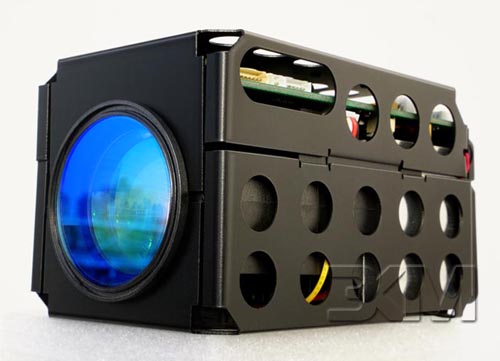Infrared Laser lighting's Classification and Performance Analysis Comparison
The difference between security monitoring night vision fill lights and infrared laser fill lights
——Infrared Laser Compensating Lamp's Classification and Performance Analysis Comparison

There are various types and names of surveillance night vision fill lights in the market, which are dazzling and difficult to choose from. The reasons for this are: firstly, the basis for classification is different, and secondly, some unscrupulous merchants deliberately hype their concepts and fish in troubled waters. Here, we will provide a detailed introduction to the types and classifications of security monitoring night vision fill lights, so that customers can choose suitable night vision monitoring fill lights based on different market demands.
Security monitoring night vision technology is divided into two types based on principles: active (active luminous night vision) and passive (passive luminous night vision). Passive light night vision includes two types: low light night vision (natural low light such as moonlight, starlight, sky glow, etc.) and thermal infrared night vision (heat emitted by objects themselves). Active night vision (using non visible light as a light source, such as infrared, ultraviolet, X-ray, etc.) currently has two main types in the market: infrared fill light and infrared laser fill light, which are also the content introduced in this article - security monitoring infrared night vision fill light.
Types and differences of night vision infrared fill lights for security monitoring
So far (February 2016), there have been five different types of infrared light sources for security monitoring night vision infrared fill lights, which are listed in order of release: the first generation traditional LED infrared lights, the second generation array LED infrared lights, the third generation dot matrix LED infrared lights, VCSEL infrared surface emitting laser fill light panels (also known as projectors), and infrared laser lights (also known as infrared laser lighting modules).
The infrared technology principles of the first, second, and third generation LED infrared lamps are the same, but the chip packaging technology and structural design are different, resulting in different performance. The VCSEL infrared surface emitting laser compensation light board uses a semiconductor laser as the light source, but its structural design and optical principle are similar to the third-generation LED infrared lights. The light source used in the infrared laser lamp is a semiconductor laser, but its structural design and optical principles are completely different from the previous four types. It includes several main parts, such as the luminous system, infrared laser optical processing system, heat dissipation system, and intelligent control system. The infrared laser is subjected to optical technology processing according to planned needs or different application environments. Moreover, high-end infrared laser lights also have intelligent and automated functions, which are combined with camera systems to form an intelligent monitoring system. These functional features are not achievable by the other four types of infrared fill lights.
The difference between the four types of monitoring night vision infrared fill lights:
second generation LED | third generation LED | VCSEL laser light board | Infrared laser lighting | |
service life | 1-3 months | 3-6 months | 3-5 years | 5-6 years |
Light attenuation rate | 20-40% | 10-20% | 2-5% | 0.5-5% |
Photoelectric conversion rate | 10-15% | 20-25% | 20-25% | 50-90% |
Intelligent functions | Non | Non | Non | Yes |
Farthest effective distance | <50m | <100m | <200m | >10km |
relative cost | low | low | medium | high |
Relative power consumption | high | high | medium | low |
brightness | low | low | medium | high |
Effect clarity | low | low | medium | high |
Note: The performance of the first generation LED infrared lights is worse than that of the second generation and has been phased out; Different brands of products have different data values, so this table only provides a range of values.
Many businesses, driven by their interests, refer to second-generation and third-generation LED infrared lights as second-generation LED laser lights, third-generation LED laser lights, second-generation infrared laser lights, third-generation infrared laser lights, array laser lights, LED laser lights, dot matrix laser lights, LED laser infrared lights, and other similar product names instead of. There are also VCSEL infrared surface emitting laser fill light panels that are directly called infrared laser lamps.
However, through the above differences and comparisons, we can easily understand why there were so many famous brands in the market when there were only four categories. By the way, although some people also call infrared laser lamps, infrared laser lamps are the mainstream and customary term in the infrared laser lighting industry.

Classification and Performance Comparison of Infrared Laser Lamps
There are various classifications of infrared laser lamps, including distance, optical power, wavelength, function, light source, safety standards, temperature range, and other classification standards. With the continuous development of technology, various classification standards are permeating each other, and the boundaries of classification are becoming increasingly blurred. Only by using infrared laser lamps to effectively illuminate the distance can product application requirements be described in both concrete and simple terms. Therefore, the infrared laser lighting industry and its application market are gradually using effective lighting distance as the best standard for dividing infrared laser lamps.
Due to the high sensitivity of the security monitoring market to cost and price, the classification of light efficiency distance is relatively detailed. In the early stage, there were 50, 100, 200, 300, 400, 500, 600 meters and other levels per 100 meters. Infrared laser lamps were classified into three categories: close range (within 100 meters), medium to long range (within 500 meters), and far range (over 500 meters).
With the development of infrared laser technology and the continuous expansion of market applications, the illumination distance of infrared laser lamps is also getting farther and farther, with products appearing at 1000 meters, 2000 meters, 3000 meters... and even over 10000 meters. On the other hand, overly detailed product segmentation is not conducive to cost control and production management of infrared laser lamps. The original level division and classification are becoming increasingly unsuitable for market applications and the development requirements of production and manufacturing. The mainstream manufacturers in the industry have gradually simplified the distance classification levels of infrared laser lamps to 300, 500, 800, 1000, 1500, 2000, 3000, 5000, 10000 meters, etc. The distance classification of products has also been reclassified into three categories: medium distance (within 500 meters), long distance (800-2000 meters), and ultra long distance (over 2000 meters). The comparison of distance division between the new and old versions is shown in the table below:
Old Distance Classification | Close range | Medium to Long Range | long distance |
<100m | <500m | >500m | |
New Distance Classification | Medium to Long Range | long distance | Ultra Long Range |
<500m | 800-2000m | >2000m |
Comparison Table for Distance Classification of New and Old Infrared Laser Lighs
The second popular classification in the market is based on optical power: 1, 2, 3, 4, 5,... nW. Because in the early days, a certain amount of light power usually had corresponding illumination distances, such as 1W of light power, which is usually an effective illumination distance of 200 meters, 2W corresponding to 300 meters, 3W corresponding to 500 meters, 5W corresponding to 800 meters, and 10W corresponding to 1000 meters. Therefore, as long as the optical power of the infrared laser lamp is known, the effective illumination distance range of the infrared laser lamp can be basically known.
However, the corresponding value between light power and lighting distance is not fixed, and the lighting distance corresponding to products of the same power may vary between different brands or even at different stages of the same brand. As shown in the table below:
Brand / Power | 2W | 3W | 5W | 8W | 10W | 12W |
3KM | 500m | 500m | 800m | 1000m | 1000m | 1500m |
Others A | 300m | 500m | 800m | 800m | 1000m | 1200m |
Others B | 200m | 300m | 500m | 800m | 900m | 1000m |
The effective illumination distance of infrared laser lamps with different brands and the same optical power is not consistent
It can be seen that there are certain misconceptions in dividing by power, especially with the rapid development of infrared laser technology, which will become increasingly obvious, chaotic, and unable to adapt to market demand.
The third classification is based on the wavelength of infrared laser lamps. There are various near-infrared wavelengths available on the market, including 808, 810, 830, 850, 940, 950, 960, 980, and 1100nm. In night vision monitoring applications, the longer or shorter the wavelength, the better its performance. Due to the different functional characteristics of infrared lasers with different wavelengths, they are generally comprehensively measured and selected based on practical application requirements from multiple aspects such as red explosion, fog penetration, luminous power, camera sensitivity, effective distance, and power consumption.
It should be noted that the occurrence of numerous similar wavelength values is not only due to the differences in the emitted light waves and positive and negative errors of the laser itself, but also due to the deliberate competitive strategy of merchants. Because, in fact, the same function is within a certain wavelength range, and the effect difference between different values within the range is not significant. Below, we will list the functional characteristics of each wavelength into three levels based on the seven major factors and compare them:
Functional Features / Wavelength | A level | B leve | C leve |
808、810、830、850 | 940、950、960 | 980、1100 | |
Red explosion phenomenon | Yes | Faint | Non |
Mist permeability | Low | Medium | Better |
Luminous power | High | Medium | Low |
Camera sensitivity | High (More than 10 times B) | Low | Low |
Maximum effective lighting distance | Ultra Long Range | Medium to close range | close range |
Consumption | Low | MediumMore than 4 times B) | High |
Comparison of functional characteristics of multiple wavelengths that can be divided into three levels and different levels
The fourth classification is based on functional characteristics, that is, using a certain function of infrared laser lights as a classification, such as automatic dimming, synchronous zoom, intelligent control, remote control, fog penetration, coastal defense, and so on. There is no fixed standard for classification, and most of it is just a marketing strategy for merchants. Moreover, with the development of infrared laser technology, the homogenization of products is becoming increasingly high, and these classifications will gradually become blurred or even disappear.
There are several other non popular classification standards: laser principles, temperature ranges, and safety standards.
1) There are two types of laser principles: edge emitting and surface emitting.
2) The temperature range is divided into three types: commercial grade (0 ℃~70 ℃), ultra commercial grade or ordinary industrial grade (-40 ℃~80 ℃), and international industrial grade (-40 ℃~85 ℃).
3) The classification of safety standards is based on the laser level classification standards corresponding to the output optical power, namely 1, 2, 3 (3A, 3B), and 4 categories.
However, in market applications, it is more customary to view these classification standards as the quality and performance of infrared laser lamps.
When choosing an infrared laser lamp, as long as you consider four factors: distance, power, wavelength, and function, you can accurately choose the product that suits you.
